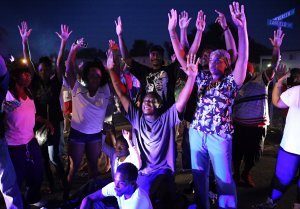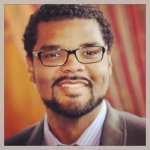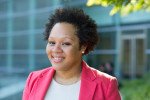
“Don’t shoot us!” cry protestors as they confront police officers arriving to break up a crowd on Canfield Dr. in Ferguson on Saturday, Aug. 9, 2014. Photo by David Carson.
The challenges of reporting on the Ferguson, Missouri, shooting death case and the sometimes-violent protests in its aftermath will be the topic of a panel discussion in February, sponsored and hosted by the John Seigenthaler Chair of Excellence in First Amendment Studies.
“From the Front Lines of Ferguson: Covering the new Civil Rights Movement” is set for Feb. 10 at 7 p.m. at MTSU’s Tucker Theater. The event is free of charge and open to the public.
Composed of media members and a social media activist, the panel will examine the First Amendment aspects of the Ferguson case from a front-lines vantage point as well as discuss reporting challenges and successes of such a highly volatile, high-profile news story. The Ferguson case continues to garner national and international attention.
Michael Brown, an unarmed black teenager, was shot and killed on Aug. 9, 2014, by Darren Wilson, a white police officer in the mostly black St. Louis suburb of Ferguson. Protests over the shooting continued for weeks afterward in the Ferguson area. When the St. Louis County prosecutor announced on Nov. 24, 2014, that a grand jury decided not to indict Wilson, protests raged anew locally, nationally and internationally.
Panelists include:
-
David Carson, St. Louis Post-Dispatch. A Boston native, Carson has worked as a staff photographer-videographer at the Post-Dispatch since 2000. His photos of Ferguson have been seen both in the Post-Dispatch as well as in media outlets across the country and internationally.
-
Antonio French. French is serving his second term as alderman for the 21st Ward in St. Louis, where he was born and raised. French has been part of Ferguson’s peacekeeping force as well as one of the most active social media reporters – some 300 tweets a day at one point – sharing updates and short videos via his Twitter account @AntonioFrench. “French’s face is a symbol of the Ferguson crisis,” the St. Louis Post-Dispatch wrote in late August 2014.
-
Yamiche Alcindor, USA Today. Alcindor has been a staff reporter for USA Today since 2011. As a member of the breaking national news team, she has covered the events of Ferguson and previously covered stories such as the bombing of the Boston Marathon, the shooting at Sandy Hook Elementary in Newtown, Connecticut, as well as the trial of George Zimmerman in Sanford, Florida.
“The Ferguson story in many ways parallels the Freedom Rides during the Civil Rights Movement of the early 1960s, something John Seigenthaler was intimately involved with as a Justice Department aide in the Kennedy administration,” said Pat Embry, director of the Seigenthaler Chair.
As an aide to Attorney General Robert Kennedy, Seigenthaler, who died at age 86 on July 11, 2014, took a lead pipe to the head from a Ku Klux Klansman as he rushed to protect Freedom Riders arriving in Montgomery, Alabama.
After surviving the attack, he went on to become one of the country’s most passionate First Amendment advocates as editor, publisher and president of The Tennessean newspaper in his hometown of Nashville. He later was the first editorial director of USA Today. Seigenthaler founded the Newseum Institute’s First Amendment Center in 1991 with the mission of creating national discussion, dialogue and debate about First Amendment rights and values.
The trio of “From the Front Lines of Ferguson” panelists have been in the thick of the coverage since its August 2014 beginnings.
The Post-Dispatch’s Carson has covered wars in Afghanistan and Iraq for the newspaper, but even he was unprepared for the unpredictability of covering the events. Wearing military-grade body armor and a helmet and carrying a gas mask, cameras, multiple lenses and a full backpack of gear, Carson was knocked to the ground by a blow to the head from protestors during their confrontation with police.
Carson previously worked at the Naples Daily News in Florida, the Providence Journal-Bulletin in Rhode Island and as a free-lance photographer in New England. Among numerous awards, Carson was named the National Press Photographers Association Region 7 Photographer of the Year from 2009-2011. In 2009 he was a part of a team recognized as a finalist for the Pulitzer Prize in breaking news for their coverage of the Kirkwood City Hall shootings. He attended college at the Rochester Institute of Technology.
Alderman and activist French was arrested for unlawful assembly in the early days of the Ferguson protests. He opened a community outreach center in the area after the Brown shooting only to see it burned to the ground in the violent protests that followed the grand jury’s decision not to indict Wilson. In 2012, French founded the North Campus, an in-school and after-school tutoring initiative molded after the Harlem Children’s Zone in New York City. In December 2014, he earned an executive MBA from the Olin Business School at Washington University in St. Louis. He is a graduate of Auburn University.
While covering the Ferguson story, USA Today’s Alcindor imbedded herself with the St. Louis County Police Department’s Tactical Operations Team, producing a story and video. She managed to gain the trust of Brown’s family during the final moments of the grand jury deliberations and the no-indictment announcement from the grand jury.
Alcindor previously worked as a staff writer at Newsday and interned at The Washington Post, The Seattle Times, The Miami Herald and Memegi, the newspaper of Botswana. In 2013, she was named Emerging Journalist of the Year by the National Association of Black Journalists. Based in New York City, she earned a bachelor’s degree from Georgetown University and is working on a master’s degree at New York University.
“First Amendment rights of freedom of speech, of the press, of the rights to peaceably assemble, and to petition the Government for a redress of grievances all have come into play in Ferguson and elsewhere in the country,” Embry said. “Police, protestors and the press have an ongoing stake in protecting our civil rights while at the same time preserving the peace.”
The Seigenthaler Chair of Excellence in First Amendment Studies was instituted in 1986 to honor his lifelong commitment to free expression values. Past chair holders have included former Chicago Tribune editor Jim Squires and former Atlanta Journal-Constitution editor Bill Kovach. In 2002, former Vice President Al Gore participated in a year-long lecture series on “Media and Democracy” in conjunction with the Chair.
Speakers and panelists sponsored or partially sponsored by the Seigenthaler Chair include: syndicated columnists Tom Wicker and Carl Rowan, journalists and authors David Halberstam and Carl Bernstein, TV commentators and anchors Eugene Robinson and Candy Crowley, NPR host Terry Gross and Ms. magazine co-founder and feminist Gloria Steinem.





Your bias is showing, even in your description of the Ferguson case. You say clearly what officer Wilson did. He “shot and killed” Michael Brown. But you make no mention whatsoever of what Michael Brown did. He’s described simply as “an unarmed teenager.” Why are his actions not mentioned? You remember his actions, don’t you? Here’s what the information provided after the grand jury’s decision revealed: He committed a strong-arm robbery and was asked by officer Wilson to move out of the middle of the street as Brown and his buddy were walking shortly after the robbery. Then Brown (an extremely large person who was legally an adult and had drugs in his system on the day of the incident) attacked Wilson before Wilson could exit his squad car. He assaulted Wilson and fought for his gun, which discharged in the car. When Brown and his buddy started to leave, Wilson got out of his car and followed them, telling Brown to stop. Brown turned and moved toward Wilson and when he refused to stop as instructed by Wilson, Wilson fired his weapon to stop Brown from getting close enough to assault him again. Brown did stop . . . then, according to witnesses (some of whom were black), he did a “bull rush” at officer Wilson, who again told him to stop. When Brown didn’t stop, he was shot again until he did stop. And he died. That sounds a bit different than just saying officer Wilson “shot and killed” an “unarmed teenager,” doesn’t it? Brown’s fate was in his own hands at every turn. Even the follow-up investigation of Eric Holder (who was incredibly inflammatory in his comments about the case) agreed with the grand jury’s findings. Officer Wilson did nothing wrong. But that didn’t matter to the protesters. Let’s hope the actual panel discussion is more fact-based than your description of it is. By the way, on a related topic, not a single credible witness said that Michael Brown ever raised his hands or said “Don’t Shoot.” Not one, including the black witnesses. Yet those fabricated actions have been the justification for nationwide protests. I would ask you to inquire of the panel if they think the media’s reluctance to pass on that extremely vital piece of information makes them culpable in any violence resulting from protests. And comparing the Ferguson case with the Freedom Rides? Puh-leeeeeze! There is no comparison. The freedom riders were absolutely trying to right serious wrongs in our country. They were brave and they were occupying the moral high ground throughout their dangerous campaign. The Ferguson riots over a legal decision that was based on fact rather than on racial and/or police animosity could not be more different. It seems, based on what I’ve read here about the panel, that you’ve got the liberal perspective of the Ferguson events very well covered. An objective viewpoint might be nice.
Im sure most are going with their minds made up.
We hope to see you at the event on Tuesday.